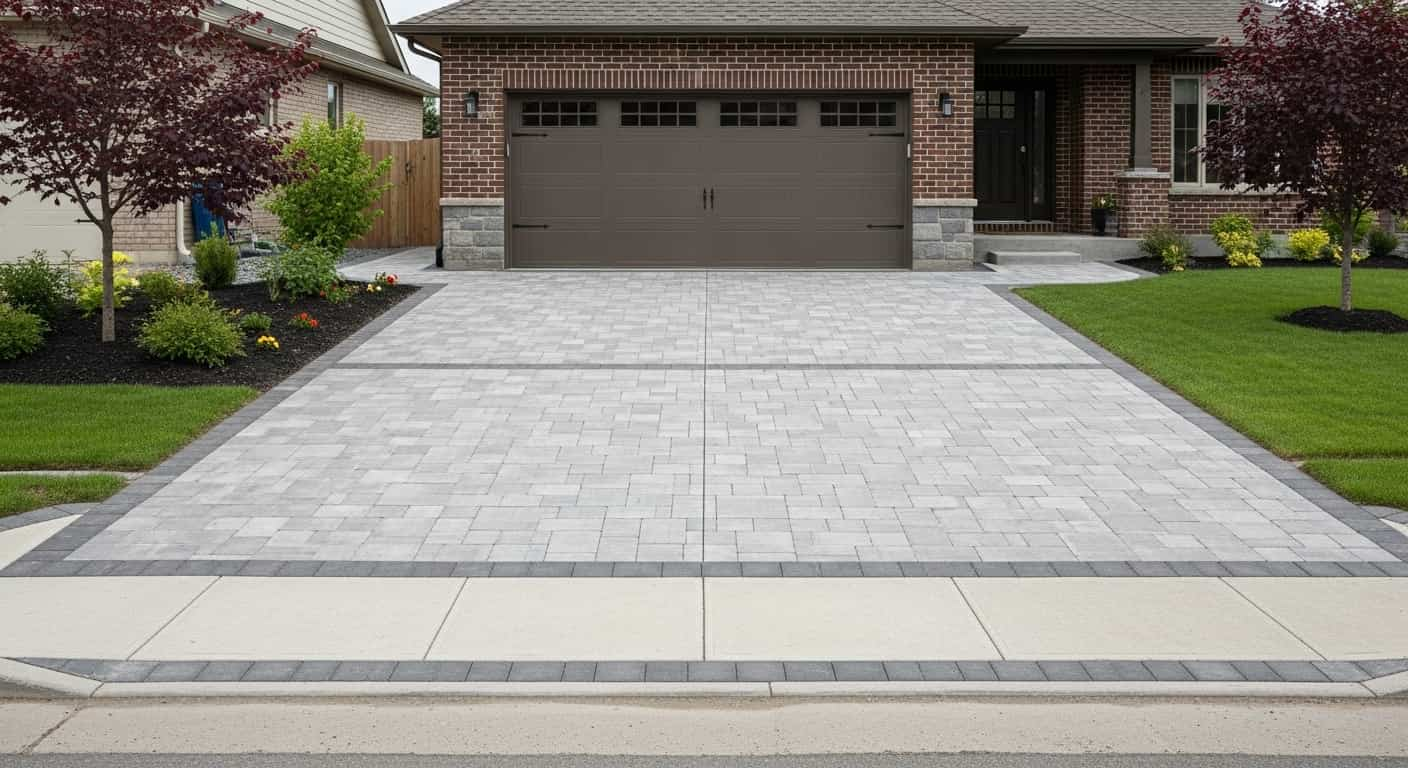Introduction
A permeable driveway is more than just a place to park your car—it’s a smart, eco-conscious choice that’s gaining popularity among homeowners.
Unlike traditional concrete or asphalt driveways, a permeable driveway allows water to pass through its surface, reducing runoff and supporting a healthier environment.
This article dives into what makes permeable driveways special, their benefits, types, installation process, and how they can transform your property. Whether you’re a homeowner looking to upgrade or simply curious about sustainable landscaping, this guide has you covered.
What Is a Permeable Driveway?

A permeable driveway, sometimes called a porous or pervious driveway, is designed to let rainwater seep through its surface into the ground below. Traditional driveways are impermeable, meaning water runs off into storm drains, often carrying pollutants like oil or debris.
A permeable driveway, on the other hand, acts like a sponge, absorbing water and filtering it naturally through layers of soil and gravel.
This innovative design helps manage stormwater, prevents flooding, and reduces strain on local drainage systems. Permeable driveways are made from materials like porous asphalt, pervious concrete, or interlocking pavers with gaps for water to flow through. They’re not only functional but also add aesthetic appeal to your property.
Why Choose a Permeable Driveway?

Choosing a permeable driveway offers multiple benefits for homeowners, the environment, and even your wallet in the long run. Here’s why they’re worth considering:
1. Environmental Benefits
Permeable driveways are a game-changer for eco-friendly landscaping. By allowing water to infiltrate the ground, they:
- Reduce runoff: According to the U.S. Environmental Protection Agency (EPA), impermeable surfaces like traditional driveways contribute to 50-70% of urban runoff. Permeable driveways can reduce this significantly.
- Filter pollutants: Water passing through the driveway’s layers gets naturally filtered, removing contaminants before they reach groundwater or nearby streams.
- Support groundwater recharge: They help replenish aquifers, which are critical for maintaining local water supplies.
2. Flood Prevention
Heavy rain can turn a traditional driveway into a mini river, leading to pooling water or flooding in your yard. A permeable driveway absorbs water, reducing the risk of floods and erosion on your property.
3. Durability and Low Maintenance
Permeable driveways are built to last. Materials like permeable pavers or porous concrete are designed to withstand heavy loads while maintaining their water-filtering ability. With proper care, they can last 20-30 years or more.
4. Aesthetic Versatility
From sleek modern designs to rustic stone looks, permeable driveways come in various styles. You can choose materials and patterns that complement your home’s exterior, boosting curb appeal.
5. Cost Savings Over Time
While the upfront cost of a permeable driveway may be higher than traditional options, it can save money in the long run. Reduced runoff means less damage to your property, and some municipalities offer tax incentives or rebates for installing eco-friendly features like permeable driveways.
Types of Permeable Driveway Materials

There are several materials you can choose for a permeable driveway, each with unique characteristics. Here’s a breakdown of the most popular options:
1. Permeable Pavers
These are interlocking bricks or tiles with gaps filled with gravel or grass. They’re highly customizable and come in various shapes, colors, and textures.
- Pros: Attractive, easy to replace individual pavers, durable.
- Cons: May require occasional weeding in gaps.
2. Porous Concrete
This is a special type of concrete with tiny voids that allow water to pass through.
- Pros: Smooth surface, cost-effective, low maintenance.
- Cons: Less visually appealing than pavers, may clog over time if not maintained.
3. Porous Asphalt
Similar to porous concrete, this material has a porous structure that lets water filter through.
- Pros: Affordable, quick to install, good for large driveways.
- Cons: Less durable in extreme climates, may need periodic sealing.
4. Gravel or Crushed Stone
A simple and budget-friendly option, gravel driveways are naturally permeable when laid over a proper base.
- Pros: Low cost, easy to install, rustic charm.
- Cons: May shift over time, requires occasional topping up.
5. Grass Pavers
These are grids filled with soil and grass, blending the look of a lawn with the functionality of a driveway.
- Pros: Eco-friendly, visually unique, great for low-traffic areas.
- Cons: Not suitable for heavy vehicles, requires mowing.
How Does a Permeable Driveway Work?
The magic of a permeable driveway lies in its layered construction. Each layer plays a role in managing water and ensuring durability:
- Surface Layer: This is the visible part, made of permeable pavers, porous concrete, or gravel. It allows water to pass through while supporting the weight of vehicles.
- Base Layer: A layer of crushed stone or gravel provides structural support and additional water storage.
- Subbase Layer: This deeper layer of larger stones enhances drainage and prevents soil compaction.
- Geotextile Fabric: Often placed between layers, this fabric prevents soil from mixing with the gravel while allowing water to flow.
When rain falls, water passes through the surface, gets filtered by the lower layers, and either soaks into the ground or is directed to a drainage system. This process mimics natural water cycles, making permeable driveways an environmentally sound choice.
Installation Process for a Permeable Driveway
Installing a permeable driveway requires careful planning and professional expertise. Here’s a step-by-step overview:
- Site Assessment: A contractor evaluates your property’s soil type, slope, and drainage needs. Sandy soils are ideal for permeable driveways, while clay-heavy soils may need extra preparation.
- Excavation: The site is dug out to create space for the layered system, typically 12-18 inches deep.
- Base Preparation: A geotextile fabric is laid, followed by layers of crushed stone or gravel, compacted for stability.
- Surface Installation: The chosen material (pavers, concrete, etc.) is installed, ensuring proper alignment and gaps for water flow.
- Finishing Touches: Edges are secured, and the surface is tested for drainage efficiency.
The process can take 3-7 days, depending on the driveway size and material. Hiring a professional is recommended to ensure proper installation and long-term performance.
Maintenance Tips for Your Permeable Driveway
A permeable driveway is low-maintenance but not maintenance-free. Follow these tips to keep it in top shape:
- Regular Cleaning: Sweep debris like leaves or dirt to prevent clogging. A pressure washer can help clear fine particles.
- Weed Control: For paver driveways, remove weeds from gaps or use eco-friendly herbicides.
- Inspect Drainage: After heavy rain, check for pooling water, which may indicate clogs.
- Replenish Gravel: For gravel driveways, add fresh material every few years to maintain a level surface.
- Winter Care: Avoid using harsh de-icing chemicals, as they can damage the surface or pollute groundwater.
With proper care, your permeable driveway will stay functional and attractive for decades.
Permeable Driveway vs. Traditional Driveway: A Comparison
To help you decide, here’s how a permeable driveway stacks up against a traditional one:
| Feature | Permeable Driveway | Traditional Driveway |
| Water Management | Allows water to seep through, reducing runoff | Water runs off, increasing flood risk |
| Environmental Impact | Eco-friendly, filters pollutants | Contributes to pollution and runoff |
| Durability | 20-30 years with proper maintenance | 15-25 years, depending on material |
| Cost | Higher upfront, long-term savings | Lower upfront, higher maintenance costs |
| Aesthetics | Highly customizable, various styles | Limited design options |
Real-Life Examples of Permeable Driveways
Permeable driveways are being used across the U.S. and beyond. For instance:
- In Seattle, a city known for heavy rainfall, permeable driveways have reduced stormwater runoff by 30% in some neighborhoods, according to local studies.
- A homeowner in California replaced their asphalt driveway with permeable pavers, cutting their water bill by reusing filtered rainwater for irrigation.
- In the UK, permeable driveways are often required for new builds to comply with sustainable drainage regulations.
These examples show how permeable driveways can work in different climates and settings, delivering both practical and environmental benefits.
Common Myths About Permeable Driveways
Despite their growing popularity, some misconceptions persist about permeable driveways. Let’s debunk a few:
- Myth 1: They’re not strong enough for heavy vehicles. Fact: Properly installed permeable driveways can handle cars, trucks, and even RVs.
- Myth 2: They’re too expensive. Fact: While initial costs are higher, long-term savings on maintenance and potential tax incentives make them cost-competitive.
- Myth 3: They clog easily. Fact: With regular cleaning, clogs are rare, and most systems are designed to maintain permeability.
Are Permeable Driveways Right for You?
A permeable driveway is an excellent choice if:
- You live in an area with heavy rainfall or strict stormwater regulations.
- You want to reduce your environmental footprint.
- You’re looking for a durable, low-maintenance driveway with aesthetic appeal.
- Your property has good soil drainage or you’re willing to invest in proper base preparation.
However, they may not be ideal for areas with heavy clay soil or extreme freeze-thaw cycles, as these conditions can affect performance without proper design.
Cost Considerations
The cost of a permeable driveway varies depending on materials, size, and labor. On average:
- Permeable Pavers: $10-$30 per square foot.
- Porous Concrete/Asphalt: $8-$20 per square foot.
- Gravel: $2-$8 per square foot.
Additional costs may include excavation, base materials, and professional installation. Check with local authorities for rebates or incentives, as many offer financial support for sustainable upgrades like permeable driveways.
How to Get Started
Ready to install a permeable driveway? Follow these steps:
- Research Local Regulations: Some areas require permits or have specific guidelines for permeable surfaces.
- Hire a Professional: Look for contractors experienced in permeable driveway installation. Ask for references and examples of past work.
- Choose Your Material: Consider your budget, aesthetic preferences, and traffic needs.
- Plan for Maintenance: Set a schedule for cleaning and inspections to keep your driveway in top condition.
Conclusion
A permeable driveway is a smart investment for homeowners who value sustainability, durability, and style. By allowing water to seep into the ground, it reduces runoff, prevents flooding, and supports a healthier environment.
With various materials like permeable pavers, porous concrete, or gravel, you can create a driveway that’s both functional and visually appealing. While the upfront cost may be higher, the long-term savings and eco-friendly benefits make it worthwhile.
Whether you’re upgrading your home or planning a new build, a permeable driveway is a practical, forward-thinking choice that benefits both you and the planet. Start exploring your options today and take a step toward a greener future.






More Stories
How To Style A Coffee Table For Every Home
How to Decorate Your Home for Christmas Like a Pro
15 Easy Steps to Build a DIY Pergola: A Complete Homeowner’s Guide